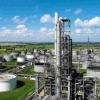|
|

Calculation Of Design Pressure
Started by Afshin445, Feb 21 2011 08:41 PM
8 replies to this topic
Share this topic:
#1

Posted 21 February 2011 - 08:41 PM
Dear All,
I want to ask is anybody have any reference about how we calculate design pressure for a positive
displacement compressor in upstream and downstream of compressor.
Yhank you in advance for your advise.
Best Regards
Afshin
I want to ask is anybody have any reference about how we calculate design pressure for a positive
displacement compressor in upstream and downstream of compressor.
Yhank you in advance for your advise.
Best Regards
Afshin
#2

Posted 21 February 2011 - 10:16 PM
Afshin,
No you don't directly provide a DP for the PD compressor since the compressor will keep building up pressure in a shut-off or blocked-in condition till the relief valve pops or the PD compressor goes into total recycle or goes into the unloading mode.
You can have two approaches to fix the design pressure:
1. Based on the pressure required at the compressor discharge provide a margin on this value (say 25%) and set the relief valve at this set pressure. This becomes your DP.
2. Decide the weakest component (the one with the lowest pressure rating) in the connected piping and system at the discharge and consider the pressure rating of this weakest component as DP. Generally, the flange is the weakest component in any connected piping. Thus if your connected piping is of 600 # rating then you find out the pressure rating of the 600 # flange according to ASME B16.5 for the given material class and for a given design temperature. This then becomes your DP for the compressor and you should set the RV set pressure this value.
Hope this helps.
Regards,
Ankur.
No you don't directly provide a DP for the PD compressor since the compressor will keep building up pressure in a shut-off or blocked-in condition till the relief valve pops or the PD compressor goes into total recycle or goes into the unloading mode.
You can have two approaches to fix the design pressure:
1. Based on the pressure required at the compressor discharge provide a margin on this value (say 25%) and set the relief valve at this set pressure. This becomes your DP.
2. Decide the weakest component (the one with the lowest pressure rating) in the connected piping and system at the discharge and consider the pressure rating of this weakest component as DP. Generally, the flange is the weakest component in any connected piping. Thus if your connected piping is of 600 # rating then you find out the pressure rating of the 600 # flange according to ASME B16.5 for the given material class and for a given design temperature. This then becomes your DP for the compressor and you should set the RV set pressure this value.
Hope this helps.
Regards,
Ankur.
#3

Posted 21 February 2011 - 10:28 PM
Afshin:
Your query is very difficult to understand and therefore it is not possible to give a reply.
There has never been any instance where I have had to calculate a design pressure for a positive displacement compressor – nor have I ever heard of such a need. a positive displacement compressor is used to move a determined quantity of gas or vapor from one pressure level to a higher one – usually for the purpose of transporting the gas or raising it to a higher pressure at the same time. There may be other motives, but those are the basic ones.
Normally, the maximum pressure rating of a positive displacement compressor is set by the process pressures that it will have to confront while doing its job of either transporting the gas or simply compressing it.
You obviously have a compressible fluid (a gas) that you want to transport. Or do you simply want to compress it for storage purposes? Tell us what your scope of work is, your detailed basic data and supply us with a sketch of your process – such as a Process Flow Diagram. If you furnish that information we may understand what you are trying to do.
#4

Posted 22 February 2011 - 06:44 AM
Afshin,
In my view, the design pressure should be determined in the same way as for any other piece of process equipment. The equipment is part of a system. The process engineer should consider the normal operating pressure required in the system on the discharge side of the compressor (such as a pipeline inlet, a process unit, etc). Then, the engineer defines the maximum required operating pressure. Then, add a pressure margin to allow for control variation, upset conditions etc, and to allow you to fit a high pressure trip which is set above the max operating but below the design pressure. That then is your lowest design pressure. You can decide to go to a higher pressure, for example, the pressure limit of the flange rating that you want to use for piping on the discharge side.
When you have set the design pressure in this way, that becomes the set pressure of the relief valve on the compressor. For a recip compressor, that relief valve must be sized for the full flow of the machine.
On the suction side, work in the same way. Consider the operating conditions of the system on the suction side and determine the maximum operating pressure, then apply a margin.
You then put these design pressures on the process data sheet for the machine. The supplier's machine might be mechanically designed to withstand higher pressures, that is fine, it is the design pressures of the connected systems that the process engineer is responsible for.
Paul
In my view, the design pressure should be determined in the same way as for any other piece of process equipment. The equipment is part of a system. The process engineer should consider the normal operating pressure required in the system on the discharge side of the compressor (such as a pipeline inlet, a process unit, etc). Then, the engineer defines the maximum required operating pressure. Then, add a pressure margin to allow for control variation, upset conditions etc, and to allow you to fit a high pressure trip which is set above the max operating but below the design pressure. That then is your lowest design pressure. You can decide to go to a higher pressure, for example, the pressure limit of the flange rating that you want to use for piping on the discharge side.
When you have set the design pressure in this way, that becomes the set pressure of the relief valve on the compressor. For a recip compressor, that relief valve must be sized for the full flow of the machine.
On the suction side, work in the same way. Consider the operating conditions of the system on the suction side and determine the maximum operating pressure, then apply a margin.
You then put these design pressures on the process data sheet for the machine. The supplier's machine might be mechanically designed to withstand higher pressures, that is fine, it is the design pressures of the connected systems that the process engineer is responsible for.
Paul
#5

Posted 22 February 2011 - 07:10 AM
Paul:
You mean we have two different design pressure, one for suction and one for discharge?
Regards
Afshin
You mean we have two different design pressure, one for suction and one for discharge?
Regards
Afshin
#6

Posted 22 February 2011 - 07:11 AM
Ankur,
Thank you for your fast reply and information.How we can have estimatethis margin?
What's the basis of 25%?
In other hand I think your recommendetion about weak point is we don't want to change pipe rating because of this margin,am I true?
Regards,
Afshin
Thank you for your fast reply and information.How we can have estimatethis margin?
What's the basis of 25%?
In other hand I think your recommendetion about weak point is we don't want to change pipe rating because of this margin,am I true?
Regards,
Afshin
#7

Posted 22 February 2011 - 09:51 AM
Afshin,
25% is not gospel. You can use a different value based on your own design experience, standards followed by your company for margin in arriving at design pressure or practices followed by reputed companies such as Shell, Total, Exxon etc.
The second paragraph of your response is not clear to me.
In a connected system (equipment + piping) one approach of design is to fully rate the complete system for one design pressure value instead of rating one sub-system at a higher value and another at lower value and then providing relief or instrumented protective devices for the lower rated sub-system.
What I am suggesting is that if you are connecting a piping of certain pound rating (e.g. 600 #) then you could rate or provide the design pressure based on the weakest component in the system which usually are the flange connections of the system.
Unfortunately this is the best explanation I can provide and leave it to your understanding being aware of the fact that English is not your native lanaguage.
Regards,
Ankur.
25% is not gospel. You can use a different value based on your own design experience, standards followed by your company for margin in arriving at design pressure or practices followed by reputed companies such as Shell, Total, Exxon etc.
The second paragraph of your response is not clear to me.
In a connected system (equipment + piping) one approach of design is to fully rate the complete system for one design pressure value instead of rating one sub-system at a higher value and another at lower value and then providing relief or instrumented protective devices for the lower rated sub-system.
What I am suggesting is that if you are connecting a piping of certain pound rating (e.g. 600 #) then you could rate or provide the design pressure based on the weakest component in the system which usually are the flange connections of the system.
Unfortunately this is the best explanation I can provide and leave it to your understanding being aware of the fact that English is not your native lanaguage.
Regards,
Ankur.
#8

Posted 22 February 2011 - 10:00 AM
Look at pages 7-8 of the referenced document: http://www.standard....134/P-001e5.pdf
As said by Ankur and Paul, the values that you can find in various standards are not gospel. There are slight variations in different philosophies, but the main concept is to specify such design conditions (including safety margin) within which the equipment is supposed to operate.
As said by Ankur and Paul, the values that you can find in various standards are not gospel. There are slight variations in different philosophies, but the main concept is to specify such design conditions (including safety margin) within which the equipment is supposed to operate.
#9

Posted 25 February 2011 - 11:48 AM
Paul:
You mean we have two different design pressure, one for suction and one for discharge?
Regards
Afshin
Afshin,
Yes, that's right, for the process systems which are connected on the suction and the discharge sides, their design pressures will be different. The reciprocating machine itself will be designed for the discharge design condition. You would have to consider whether it was possible to block the machine in on the suction side and for the discharge pressure to leak back through the internal cylinder valves up to this suction block valve. In this case the discharge system design pressure should be taken back to the last block valve on the suction side. If the suction block valve was locked open, this would not be necessary in my view.
Paul
Similar Topics
Recommended Installation Location For "pressure High" InterlocStarted by Guest_omupei_* , Yesterday, 02:34 AM |
|

|
||
Design Capacity Of Hydrogen Pullet During Hydroprocessing Units UpsetStarted by Guest_Divid Kelin_* , 18 Jun 2025 |
|

|
||
Hello, Design Of Natural Gas Liquefaction Processes.Started by Guest_guoyinyanliner_* , 18 Jun 2025 |
|

|
||
Distillation Tower Top And Bottom Temperature And PressureStarted by Guest_student55_* , 27 Mar 2016 |
|
|
||
Steam Pressure In Heat ExchangerStarted by Guest_mvanrijnbach_* , 15 Apr 2025 |
|

|

 FB
FB









